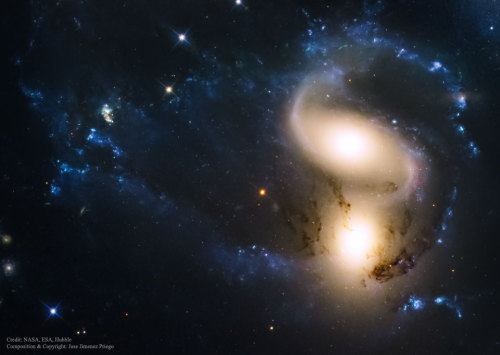Littlecadet-biguniverse - Space, Our Favorite Frontier!!

More Posts from Littlecadet-biguniverse and Others


MARTIAN STORMS - Seen in 1977 by the Viking 2 Orbiter
“Like its predecessor, the Viking 2 mission consisted of a lander and an orbiter designed to take high-resolution images, and study the Martian surface and atmosphere. Both the Viking 1 and 2 landers benefited greatly from their orbiting counterparts, which snapped images that helped mission controllers navigate the landers to safe landing sites.”
This particular image was taken by the Viking 2 Orbiter and shows a massive dust storm on the red planet. This spectacular storm can be seen on a global scale. The Viking 2 mission would end 3 years later on April 11, 1980.
Credit: NASA/JPL



Top: Hubble’s infrared vision pierced the dusty heart of our Milky Way galaxy to reveal more than half a million stars at its core. At the very hub of our galaxy, this star cluster surrounds the Milky Way’s central supermassive black hole, which is about 4 million times the mass of our sun.
Credits: NASA, ESA, and Hubble Heritage Team (STScI/AURA, Acknowledgment: T. Do, A.Ghez (UCLA), V. Bajaj (STScI)
Bottom: This annotated, infrared image from the Hubble Space Telescope shows the scale of the galactic core. The galaxy’s nucleus (marked) is home to a central, supermassive black hole called Sagittarius A-star.
Credits: NASA, ESA, and the Hubble Heritage Team (STScI/AURA) Acknowledgment: T. Do, A.Ghez (UCLA),V. Bajaj (STScI)

Three LEGO Minifigures Journey to Jupiter
Did you know that the Juno mission is also one giant leap for minifigure-kind? Three LEGO crew members have set their sights on being the first toy to visit another planet, enduring the five year, 1.75 billion mile journey aboard NASA’s Juno spacecraft. One minifigure is a likeness of Galileo Galilei – who discovered Jupiter’s four largest moons. The other two represent the Roman god Jupiter and his wife Juno. Each figure has been custom molded out of aluminum to represent their special characteristics. Jupiter carries a lightning bolt, Juno has a magnifying glass to represent her search for truth, Galileo is carrying a telescope and a model of the planet Jupiter.
To me, these minifigures add a beautifully ordinary and intensely human element to this extraordinary mission.
Explore more of the LEGO Group’s partnership with NASA at LEGO.com/Space


The giant star Zeta Ophiuchi

Colliding Galaxies NGC 7318, part of Stephan’s Quintet

Very colorful clouds of Rho Ophiuchi.
Image Credit & Copyright: Tom Masterson, ESO’s DSS
you're👏not👏a👏 real 👏astronomer👏 until 👏you've 👏shoved 👏all👏 9 👏planets 👏up 👏your👏 ass

-
 mcflies liked this · 8 months ago
mcflies liked this · 8 months ago -
 falcemartello liked this · 11 months ago
falcemartello liked this · 11 months ago -
 usedcarheaven reblogged this · 1 year ago
usedcarheaven reblogged this · 1 year ago -
 victor-ribeiro-stuff liked this · 1 year ago
victor-ribeiro-stuff liked this · 1 year ago -
 harmcityherald reblogged this · 1 year ago
harmcityherald reblogged this · 1 year ago -
 dannysmiphapples liked this · 1 year ago
dannysmiphapples liked this · 1 year ago -
 wildernestt reblogged this · 1 year ago
wildernestt reblogged this · 1 year ago -
 slowcat420 reblogged this · 1 year ago
slowcat420 reblogged this · 1 year ago -
 slowcat420 liked this · 1 year ago
slowcat420 liked this · 1 year ago -
 flexyhexy liked this · 1 year ago
flexyhexy liked this · 1 year ago -
 kawaiieggszinecookie liked this · 2 years ago
kawaiieggszinecookie liked this · 2 years ago -
 cleo7 liked this · 2 years ago
cleo7 liked this · 2 years ago -
 gosteipubliquei liked this · 2 years ago
gosteipubliquei liked this · 2 years ago -
 karim88hh2 liked this · 2 years ago
karim88hh2 liked this · 2 years ago -
 wo-ai-ni-gege reblogged this · 3 years ago
wo-ai-ni-gege reblogged this · 3 years ago -
 acept-arte liked this · 3 years ago
acept-arte liked this · 3 years ago -
 enjoythesilence771711 liked this · 3 years ago
enjoythesilence771711 liked this · 3 years ago -
 thebigmitten reblogged this · 3 years ago
thebigmitten reblogged this · 3 years ago -
 lilysmaster liked this · 3 years ago
lilysmaster liked this · 3 years ago -
 astraeasstars reblogged this · 3 years ago
astraeasstars reblogged this · 3 years ago -
 groveavenuestudio liked this · 3 years ago
groveavenuestudio liked this · 3 years ago -
 amaurijuli liked this · 3 years ago
amaurijuli liked this · 3 years ago -
 hilyana liked this · 4 years ago
hilyana liked this · 4 years ago -
 incharge694u liked this · 4 years ago
incharge694u liked this · 4 years ago -
 luciusantonius reblogged this · 4 years ago
luciusantonius reblogged this · 4 years ago -
 musicjunkyx0 reblogged this · 4 years ago
musicjunkyx0 reblogged this · 4 years ago -
 musicjunkyx0 liked this · 4 years ago
musicjunkyx0 liked this · 4 years ago -
 solargulf reblogged this · 4 years ago
solargulf reblogged this · 4 years ago -
 jcgraas liked this · 5 years ago
jcgraas liked this · 5 years ago -
 industrialized-rickets reblogged this · 5 years ago
industrialized-rickets reblogged this · 5 years ago -
 tbalsillie1973 liked this · 5 years ago
tbalsillie1973 liked this · 5 years ago -
 beelzebunny reblogged this · 5 years ago
beelzebunny reblogged this · 5 years ago -
 beelzebunny liked this · 5 years ago
beelzebunny liked this · 5 years ago
GREETINGS FROM EARTH! Welcome to my space blog! Let's explore the stars together!!!
144 posts